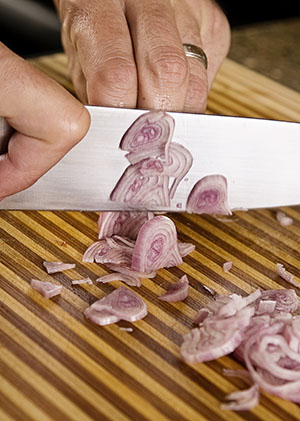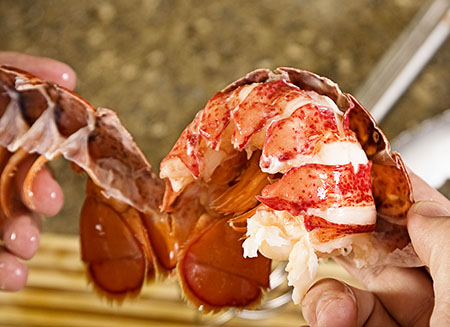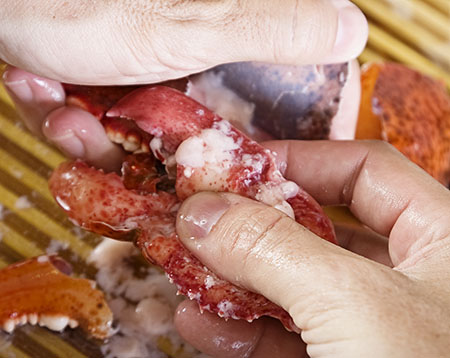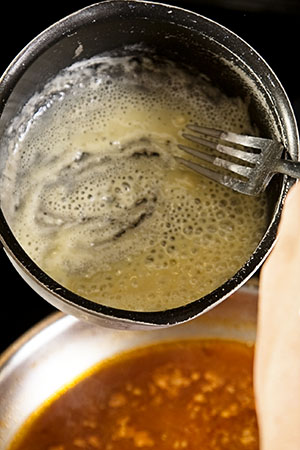PFB Challenge #4: Butter Poached Lobster with Sauce Aurore
 (Edit: Voting has started! Please vote for us and help us advance to the next challenge! http://www.foodbuzz.com/project_food_blog/challenges/4/view/1288)
(Edit: Voting has started! Please vote for us and help us advance to the next challenge! http://www.foodbuzz.com/project_food_blog/challenges/4/view/1288)
For most of my life, I was a dabbler in the kitchen. I cooked a lot, and I wasn't bad, but I winged it. Three years ago, I picked up Kitchen Confidential and it changed my outlook on cooking forever. High-level restaurant cooking had always seemed to me like some arcane master-teaches-apprentice alchemy, but then here's this punk, slacker, ex-heroin addict Anthony Bourdain who cooked at some of the best restaurants in New York. Suddenly, things seemed different.
I didn't want to go to culinary school. I didn't want to work in a restaurant kitchen. But, I did want to know how the big guys did it. I wanted to know why my sauces never turned out the same as restaurant sauces. It was gnawing me that I was missing something, and it wasn't something tangible like a pinch of saffron or a dash of black truffle oil. I knew that recipes were basically just CliffsNotes, but I was still trying to match flavors and spice, not understanding that behind all these restaurant cooks was history and technique.
It seems like there are millions of cookbooks out there, but not many dealing with technique, especially classical technique. I absorbed as much as I could through cooking textbooks. McGee, the CIA, Larousse Gastronomique, Peterson. Making veal stock, making demi glace. How does someone find that exact point where the egg yolks are just right in a Hollandaise? There is a reason many cooks either apprentice or go to culinary school -- it's easier to understand when someone who knows how to do it just shows it to you. There are colors and tastes and smells and even sounds that tell you that you're doing the right thing.
Christey is a photographer and a photojournalist. She's worked for the local papers and has her own studio. When I started to get serious about food, she was starting to get serious about food photography. Food is considered one of the hardest subjects in photography. It not only has to be technically accurate, but also pleasing on an emotional, primal level. Food is a moving target -- it spoils or runs, cools or melts. The photojournalist in her was also interested in the process I was learning. She wasn't interested in how to make Hollandaise herself, but started to shoot me as I frowned and chopped and concentrated and muttered. She started to take over the plating and food styling to learn how to grab that perfect shot.
We starting posting pictures online and had some great feedback, so we decided to jump in and start a food blog. FotoCuisine was born out of my desire to show the techniques of classical cooking I was learning, matched with Christey's desire to tell the story of how a meal comes together.
Project Food Blog Challenge #4 is: Use photography to create a step-by-step, instructional photo tutorial. It could be anything from how to bone a chicken to how to make your favorite recipe, but your photos need to guide the reader through the steps.
Christey and I decided to tackle butter poached lobster, with a sauce Aurore. The ingredients: a pound of butter, two lobsters, a shallot, a cup of lobster stock, two tablespoons tomato paste, a tablespoon of flour. A drop of caviar for garnish and a nice salty contrast. The ingredients are simple and basic, but the technique is what makes this a meal, and that's what we love to show.
Thomas Keller is widely attributed as "inventing" butter poached lobster, though poaching seafood has been around for centuries. Keller uses a beurre monté to poach his lobster, which is water added to whole melted butter to form an emulsion that won't break when heated. In a restaurant situation, beurre monté is a quick and practical way to pump out a lot of the same dishes. There are other techniques however, and I like using clarified butter, which is melted butter without the solids and water in a beurre monté. What's left is pure oil (fat), which is chemically very similar to other unrefined oils, like extra virgin olive oil.
Everything starts with a pound of unsalted butter, which when you think of it, is a beautiful thing. There were times in history where this stack of flavor would be the equivalent to liquid gold, and yet I bought this for the price of half an hour of minimum wage. The butter is gently melted it in a pot:



While the butter is melting, the lobsters need to be dispatched.


Some people are a ethically squeamish about this part, and I can understand that. There are living creatures sitting on my cutting board who are about to die for our dinner. I put in four or five years as a vegetarian, and experimentation with health, nutrition, and the ethics of the food chain was an evolving examination of life choices. But, I eat meat now, and whether I buy meat or fish wrapped in butchers paper or kill it myself, I'm still contributing to the cycle of life and death and sustenance that makes up a good part of the day to day existence on this planet. In a real sense, I feel the death of some animals like lobster, to feed other animals like Christey and me and our kids, is much more natural and ethical than what we're doing with corn and soybeans in every grocery store.
That doesn't mean we have to be cruel, though. If I eat lobster, I should be able to kill them as humanely as possible. Some cooks just pull the tails and claws off the body, but I like to kill the lobsters first, then separate the tail and claws, which are what I'm interested in for dinner. I also save the bodies, freeze them, and make lobster stock later when I have a few stacked up, which also helps use every part of these creatures that I could possibly use.
The most humane way to kill a lobster is to position the point of the knife right at the back of the body, and rock it forward to split the body in half:


There's a membrane holding the body shell to the tail shell, and a nick with the tip of the knife will make it easier to pull apart:


The claws come off with a twist:



Unlike shrimp, you can't pull raw lobster meat from the shell -- it'll stick and fall apart. But, if the lobster is par-boil for only a minute or two, the outside of the meat separates away from the shell and the meat can be removed without cooking the whole lobster.
So, the claws and tails are dropped in heavily salted boiling water:


After a minute minute or two, the lobster is removed from the water:

While the lobster cools, the butter is starting to separate -- there are frothy bits on the top, and some solid bits in a water layer on the bottom. If the butter is cooked until the solids on the bottom are gently browned, it would give the clarified butter an almost nutty taste, which is called ghee in India.
But, it isn't taken to that point. After skimming off much of the froth, the top, clarified part is strained through a double-layer of cheesecloth to catch any remaining solids:



The clarified butter makes up about 3/4 of the whole butter, meaning 1/4 is water and solids and is discarded. The strained butter is poured into a clean, small pot and gently heated to 180 degrees.

Meanwhile, it's time to start the sauce. A shallot is roughly chopped (which will be strained out of the sauce later):


Normally, the shallots would be caramelized in some olive oil, but there's this wonderful clarified butter sitting in a pot, so some of that is used instead. Because there are no solids in the butter, the smoke point is much, much higher, and the butter won't burn:



Once the shallots are lightly browned, tomato paste is added to the pan and cooked until the paste starts to brown a little bit -- it will start to smell very sweet.


A cup of lobster stock is added (I had some in the freezer, but some could also be made fresh from the reserved bodies):

The sauce will reduce by about half on a slow simmer to concentrate flavors.

Time to rescue the meat from the shells.


Kitchen shears are used to cut down the bottom, then the top of the shell, trying not to cut over the top of the meat. The tail should come out whole:



There's a "vein" in the top part of the meat that should be removed, just like shrimp.

The back side of my chef's knife (sharp side up!) is used to crack open the claws and gently remove the meat from the cartilage and shell...this is really tricky. The meat is half cooked and very delicate. The goal is to get an entire claw out without damaging the meat. If a tip or edge breaks off, it's still lobster meat and still tasty, but for presentation's sake, it's best to do this slowly and carefully to preserve the shape:



The sauce has reduced by this point so it's time to make a roux -- a thicker made from butter and oil. Again, there is some lovely clarified butter sitting in a pot nearby, so a tablespoon of that is tossed into a small pot and a tablespoon of flour is tossed in, heating until it sizzles:



The roux gets added to the sauce, which thickens it:


Roux added to any stock is a sauce velouté. Velouté with tomatoes or tomato paste is a sauce Aurore, which is French for "dawn" because of it's reddish/pinkish color. Once the roux thickens the sauce, the heat is turned down and the sauce warmed until the lobster is done.
The thermometer says the butter is ready for the lobster!

The meat goes in and is almost covered by the butter.


The lobster poaches gently in the clarified butter, for maybe 5 or 6 minutes.

The sauce Aurore is strained (the shallots have done their job), and a pinch of kosher salt and some lemon juice is added, just for some brightness and to wake up the flavor a bit:




I want to use some caviar as a contrast. It'll be a pop of texture with saltiness and brininess, against the tender and subtle taste of the lobster meat. Whitefish caviar is being used, which is unfortunately dyed, so a quick rinse in water cleans it off.


The lobster is plated next to fresh baby greens, with sauce over the top and a dab of caviar up front:

One final tip: normally, clarified butter has a shelf life similar to extra virgin olive oil. This butter has just had lobster in it, however, which flavors the butter, but also adds some proteins and solids. If refrigerated, it'll probably last three or four days. But! Take advantage of it! I made scrambled eggs the next day, and they tasted like butter and lobster.



